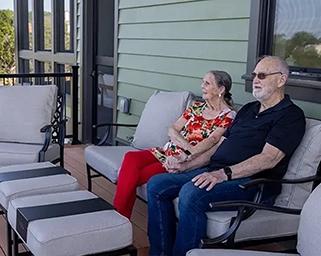Building Your Energy-Efficient Dream Home
TL;DR: When building a new home, you can make it highly energy efficient from the very beginning.
While older homes have their charm and character, building a new house is a unique opportunity to customize building materials, layouts, and add-ons that can make your home more energy efficient. Building an energy-efficient home can reduce your carbon footprint, increase your comfort, and can save you money on monthly utility bills. It’s hard to find a reason not to prioritize energy efficiency as you design and furnish your new home.
If you're in the project planning stage of building a new home, visit the Department of Energy (DOE )'s efficient home design resources that cover everything from advanced house framing to cool roofs to passive solar home design.
Let's take a closer look at some simple but effective ways that homeowners can increase the efficiency of their new homes.
A Whole-House Systems Approach to Energy Efficiency
Optimizing home energy efficiency in your new build will require a whole-house systems approach to ensure that your team is considering all of the variables that can affect energy use in the home. You may also want to consider working with an energy assessor who can provide you with a Home Energy Score.
The Home Energy Score is a national rating system developed by the U.S. Department of Energy to provide a rating for your home and provide a list of possible improvements for even more savings.
Choose energy-efficient appliances
Beyond the actual home design and choice of building materials, one of the most impactful ways to affect your energy efficiency is by installing energy-efficient appliances that can help reduce your energy and financial costs. Household appliances, like your refrigerator, dishwasher, and washing machine, account for 20 to 25% of your home’s total utility bill. ENERGY STAR®-certified appliances use anywhere from 10 to 50% less energy annually than appliances that only meet minimum efficiency standards.
To put this in perspective, it means that, for the average American family that does 300 loads of laundry per year, an ENERGY STAR washing machine can save $360 annually. Energy-efficient dryers use 20% less electricity, which can save a household $210 in electric bills over the lifetime of the appliance, and an ENERGY STAR dishwasher only costs $35 to run per year and can save households an average of 3,870 gallons of water over its lifetime.
Heat and cool your home with an energy-efficient HVAC system
Perhaps the most impactful way to make your new home more energy efficient is by considering how you will heat and cool your home. According to the U.S. Energy Information Administration (EIA), more than 50% of the average American household's energy costs stem from heating and cooling their home. The average cost to heat and cool a home is $1,346, with heating costs higher in the North and cooling costs higher in the South.
However, if just 10% of American households changed their HVAC systems to an energy-efficient system, it would reduce greenhouse gas emissions by 10 billion pounds annually (the equivalent of driving 1.2 million cars) and bring a 33% reduction in utility costs for those households.
These trusted strategies can help reduce your energy costs when it comes to heating and cooling your new home:
Invest in an ENERGY STAR®-certified HVAC system
While the initial cost of an ENERGY STAR-certified unit may be more expensive than a traditional HVAC unit, your long-term savings will make up the difference. Choosing an energy-efficient air conditioner, heat pump, or furnace that is ENERGY STAR-certified allows you to have confidence in your choice, knowing it has met or exceeded energy conservation standards set forth by the Department of Energy.
Purchase a programmable or smart thermostat
A programmable thermostat can be set to change the target temperature throughout the day to account for times when your family is at work, school, or sleeping. If you’re looking for more, consider a smart thermostat, which can be paired with your smartphone, tablet, or desktop computer to control your HVAC system from anywhere.
Consider purchasing a heat pump system
According to the Department of Energy, heat pumps can reduce your electricity for heating by as much as 50% compared to electric heating options like furnaces and baseboard heaters. Because heat pumps simply transfer existing heat in and out of the home, heat pumps can also cool your home more efficiently than other HVAC options.
Learn more in our Electrification Hub.
Consider lighting
When building your home, it is important to consider how you will light your home. Lighting accounts for approximately 15% percent of your home’s utility bills. In addition to building your home with natural light in mind, by using LED lighting, you can save $225 in energy costs annually.
LED bulbs use up to 90% less energy and last up to 25 times longer than incandescent bulbs. Choosing energy-efficient lighting is one of the easiest and fastest ways to save money and increase the energy efficiency of your home. In addition to choosing LED bulbs, also consider programmable features, like timers and dimmer switches, that provide maximum control in home lighting.
Examine water heating
Water heating is the second largest expense for utility bills and accounts for 20% of your total energy consumption. Using heated water for showers, baths, laundry, dishes, and other household chores can cost a household anywhere from $400 to $600 per year. Energy-efficient water heaters consume 70% less energy than standard electric water heaters and can help many households save hundreds of dollars each year.
Tankless water heaters are another energy-efficient water heating option. These heaters instantly heat up water as you need it, which is more efficient than keeping a tank of water hot all the time. While tankless water heaters can reduce your energy bill, they are currently more expensive than traditional water heaters. If you’re considering a tankless system, do some research to make sure the long-term energy savings will make up for the difference in price.
The placement of the water heater can also improve the energy efficiency of your home. If you live in a warmer climate, place the water heater in a cool part of the home, like a basement or garage that is not heated. Because short hot water pipes save energy and water, it may also be beneficial to place the water heater close to sinks, showers, or other appliances that use hot water.
Additionally, low-flow shower heads, toilets, and other water fixtures can help reduce and manage water usage. Ask your plumber for recommendations that will provide the right balance of comfort and efficiency for you.
Contact your local Trane dealer today
There’s never been a better or easier time to make your home energy efficient. With rising energy costs, building energy efficiency into your new home makes sense for your wallet and the planet. Get started today! Contact your local Trane dealer and ask about ENERGY STAR-qualified HVAC systems today.




